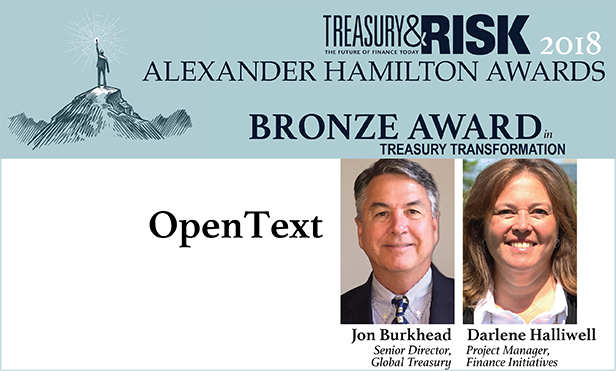
OpenText was founded in 1991 by academics looking to create asearchable online dictionary. Given this original raisond'etre, the organization's growth in the years since has beenremarkable. “We've made 61 acquisitions, deploying a total of morethan $6 billion of capital,” explains Jon Burkhead, senior directorof global treasury for OpenText. “We average two to threeacquisitions per year.”
|In its two and a half decades of existence, OpenText has evolvedinto a diversified software and services company with offeringsranging from document imaging and information management systems toa SWIFT service bureau. It has also expanded geographically: Basedin Waterloo, Ontario, OpenText operates globally, with 41 percentof sales coming from outside the Americas. Thanks to its ongoing,multifaceted growth, OpenText is a force to be reckoned with in theenterprise software market. At the same time, the acquisitions havecomplicated life for back-office functions such as treasury.
|“A few years ago, we were managing all our treasury activitieson a spreadsheet,” Burkhead says. “It worked when OpenText wassmaller, but the more acquisitions we completed, the more banks andaccounts we had to deal with. By the end of 2014, three people werespending a lot of time logging into different bank portals andmanually downloading the statements and transactions. Since weoperate two shared service centers, we support nearly 100 otherusers who were going into the bank portals to initiate payments,retrieve statements, and inquire on banking transactions. We had420 accounts at 120 different banks, and we literally had peoplewalking around with bags of tokens for accessing portals. Wecouldn't continue doing things that way.”
|OpenText undertook an initiative to rationalize its global bankaccount structure and to automate as many treasury activities aspossible. Burkhead enlisted the help of OpenText's project managerfor finance initiatives, Darlene Halliwell. Together, theyestablished a target of consolidating most of the company'sbusiness with five global banks. “We still needed regional banks insome places, either due to local laws or business considerations,”Halliwell says. “But we set a goal of reducing the total number ofbanks we worked with from 120 to less than 20.”
|Halliwell headed up a project team that consisted of subjectmatter experts from the company's accounts receivable (A/R),accounts payable (A/P), payroll, tax, controllership, and legalfunctions. “Before we launched this project, treasury did acost-benefit analysis that secured senior management's buy-in toour objectives,” Burkhead says. “The support of senior managementhelped us convince groups throughout the company to dedicateresources to our initiative.”
|The project team's first step was to select five banks as globalpartners based on their footprint, capabilities, cost, andcommercial relationship with OpenText. After making thosedecisions, OpenText invited the partner banks to join weeklyproject-update meetings. “We tapped into the banks' knowledge aboutbest practices and local banking practices,” Burkhead says. “Forexample, Citibank was one of our strategic banks, and they played akey role in helping us design the EMEA [Europe, Middle East, andAfrica] banking network and pooling structure which had morecomplexity.”
|The next step was to evaluate the rationale behind each bankaccount the company maintained. “We went region by region, accountby account, and bank by bank, and we questioned what we were doingand why we were doing it,” Burkhead says. “In the past, we hadinstances where we would open a new account just because a singlecustomer wanted to pay in a different currency than our functionalcurrency in that country. In this project, we performed acost-benefit analysis on every account. We wanted to get down toone or two operating accounts per entity per country, and to closeany account that didn't have a convincing businessjustification.”
|Another key component of the project was the deployment of acorporate treasury management system. OpenText rolled out a Kyribasolution and built a payment hub within the OpenText corporateManaged Services group. Rather than logging into a different portalfor every bank, treasury and A/P staff now initiate and approvepayments through the treasury management system, which then pushesthe payment to OpenText Managed Services for payment directlythrough to the banks. For banks that have lower volumes of OpenTexttransactions, payments flow through SWIFT. Bank statementsautomatically flow in the opposite direction.
|“The OpenText Managed Services group has become our aggregatorfor statements and payments,” Burkhead says. “Their directconnectivity to the banks has been integral to the company'sability to streamline our payment and bank account managementprocesses.”
| Liquidity management was one morearea of focus for the initiative. The project team dividedOpenText's business into regions—North America, EMEA, APAC(Asia-Pacific), and LATAM (Latin America). Cash pools weresubsequently set up in North America, EMEA, and APAC. “In EMEA andAPAC, in particular, the pooling structures are very beneficial,”Burkhead explains. “All the cash, across all those differentcountries and entities, funnels up to a single entity. In the past,treasury staff had to ensure we had the right level of liquidity inevery account by manually confirming liquidity levels on a regularbasis. The goal is to now review liquidity only at the threeaccounts at the top.
Liquidity management was one morearea of focus for the initiative. The project team dividedOpenText's business into regions—North America, EMEA, APAC(Asia-Pacific), and LATAM (Latin America). Cash pools weresubsequently set up in North America, EMEA, and APAC. “In EMEA andAPAC, in particular, the pooling structures are very beneficial,”Burkhead explains. “All the cash, across all those differentcountries and entities, funnels up to a single entity. In the past,treasury staff had to ensure we had the right level of liquidity inevery account by manually confirming liquidity levels on a regularbasis. The goal is to now review liquidity only at the threeaccounts at the top.
“The other big benefit of our cash pooling structure is that thenetting smooths out the variation in daily cash flows,” Burkheadadds. “We were able to reduce the amount of cash we keep on hand inour bank accounts worldwide. Now we can invest that money or applyit to other corporate initiatives such as acquisitions.”
|OpenText can also mobilize cash more readily with the newaccount structure than it could in the past, allowing treasury topull funds down in a matter of days, maybe even in a single day.Treasury also has better visibility into corporate cash, given thesmaller number of banks the company is working with.
|Consolidating accounts with a smaller number of banks hassubstantially reduced the bank fees OpenText pays, and moving fundsfrom cash accounts into investments has increased investmentincome. OpenText is also able to negotiate more favorable exchangerates, and staff have reclaimed a significant number of hours thatthey can spend on other activities vs. logging onto portals to sendpayments and re-keying bank statement data into spreadsheets.
|Finally, rationalizing bank accounts has reduced financialrisks. “When we were dealing with 120 different banks, it waschallenging to stay abreast of the details of the financialcondition of each bank,” Burkhead says. “Plus, every bank accountis a window of opportunity for fraud. Our consolidated accountstructure and automated treasury management system have reduced ourexposures.”
|Moving forward, Burkhead and Halliwell expect OpenText tocontinue acquisitions. However, both feel the company is now betterprepared to integrate acquisition targets efficiently into the newtreasury structure. “If an acquired entity is going to survive asan independent business unit, we look at which accounts are reallynecessary and plan to transfer those to our partner banks,”Burkhead says. “If it's not going to survive, we look at where wewill integrate it into existing entities and how to redirect itstransactions to our existing bank accounts.”
|Through the initiative, the treasury team demonstrated theirability to serve as valuable partners to other OpenText businessunits. “This project definitely gave folks in our A/R, A/P,controllership, tax, and legal teams a greater understanding ofwhat treasury does and a greater appreciation of the amount of workthat goes into opening, managing, and even closing bank accounts,”Halliwell says.
|Burkhead adds: “The holy grail for treasury is to figure out howto add value. It's in our best interests to understand the needs ofour internal customers. If we can approach them with a knowledge ofwhat they do, we will be better able to offer ideas and bestpractices for how to improve their lives. As we worked withdifferent groups from within OpenText to evaluate and revamp ourbanking structures around the world, we developed a betterunderstanding of their perspective and they began to understandtreasury better. Internal relationships are crucial, and wedefinitely improved our relationships throughout the company aspart of this project.”
Complete your profile to continue reading and get FREE access to Treasury & Risk, part of your ALM digital membership.
Your access to unlimited Treasury & Risk content isn’t changing.
Once you are an ALM digital member, you’ll receive:
- Critical Treasury & Risk information including in-depth analysis of treasury and finance best practices, case studies with corporate innovators, informative newsletters, educational webcasts and videos, and resources from industry leaders.
- Exclusive discounts on ALM and Treasury & Risk events.
- Access to other award-winning ALM websites including PropertyCasualty360.com and Law.com.
*May exclude premium content
Already have an account? Sign In
© 2024 ALM Global, LLC, All Rights Reserved. Request academic re-use from www.copyright.com. All other uses, submit a request to [email protected]. For more information visit Asset & Logo Licensing.







